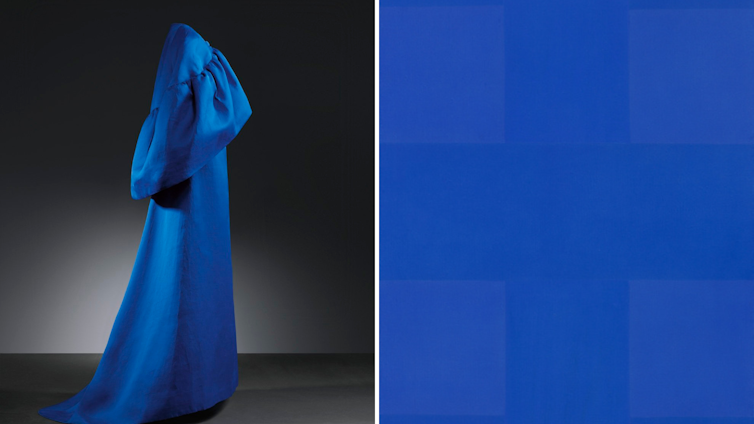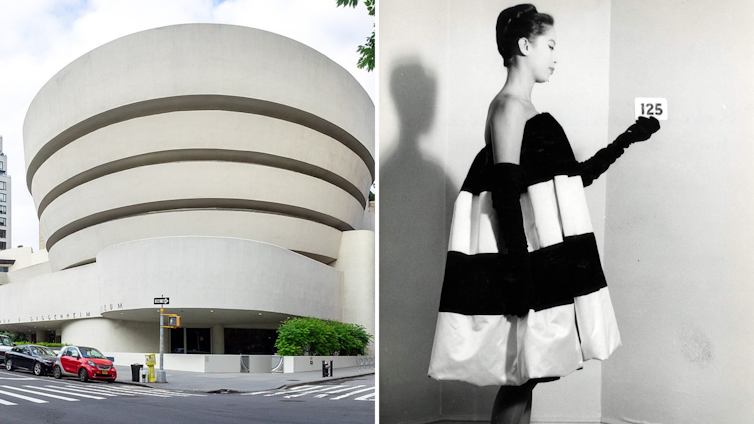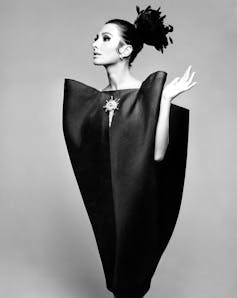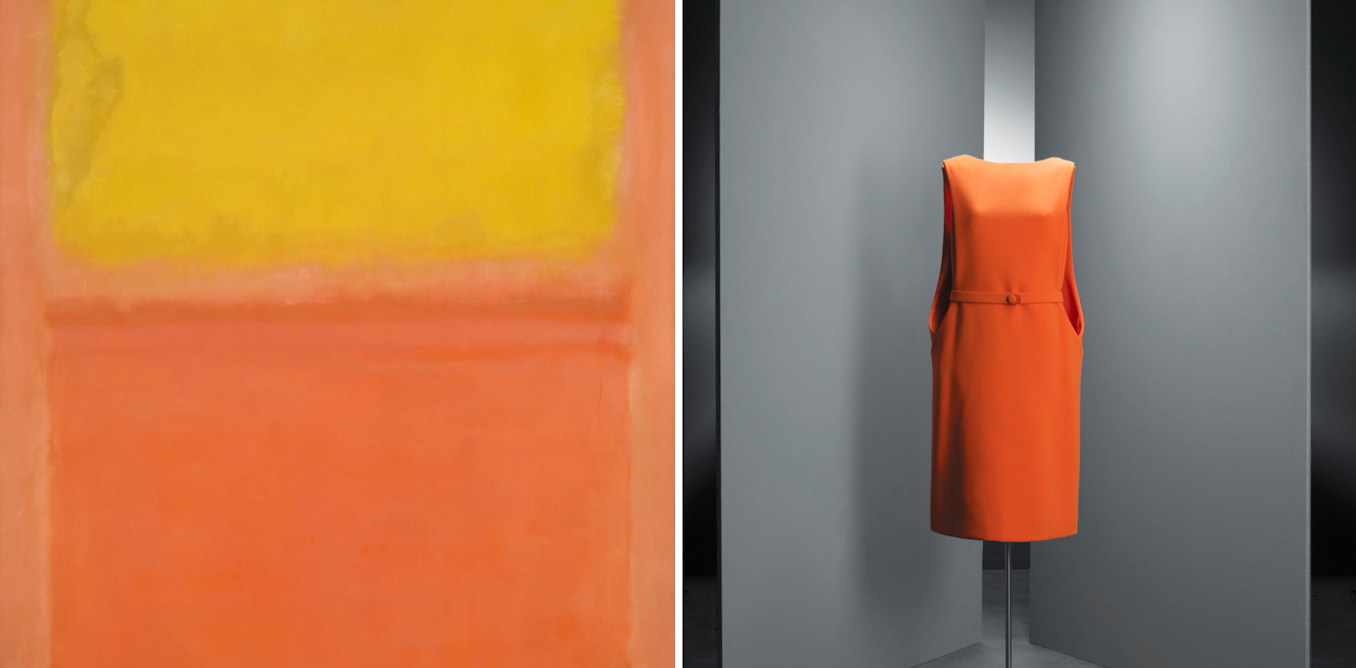In January, the TV series Cristóbal Balenciaga premiered, a story inspired by the life of the Spanish designer during his time in Paris, beginning when he arrived in 1937. The plot seeks to explore his personality and what drove him, highlighting key moments in his personal and professional life, such as his relationship with other illustrious designers, the creation of the gazar fabric, the design of Queen Fabiola’s wedding dress, and the creation of Air France’s stewardess uniforms.
Though fashion is present throughout the show’s six episodes, the couturiers’s creations are placed in the background, focusing instead on personal experiences with family, friends, colleagues and employees.
However, several scenes in the first episode present the influences that would come to mark his work. Balenciaga is seen consulting José Ortiz-Echagüe’s book España. Tipos y Trajes (“Spain: people and clothes”) , which details the country’s popular regional dress and costumes. According to written works on the Basque designer, much of his inspiration is derived from Spanish culture, painting and tradition.
For example, his 1947 bolero in blue velvet with black felt decoration and beadwork is an interpretation of bullfighters’ extravagant clothing (known in Spanish as traje de luces, literally “suit of lights”), characterised by chromatic contrast and rich embroidery and trimmings. In a similar vein, his 1949 dress with black stripes on a red background bears a striking resemblance to the traditional women’s clothing of the Pas valley, in Cantabria.
These influences were also reflected in the 2019 exhibition “Balenciaga and Spanish painting”, where pieces by the Basque designer were presented alongside a selection of works by Spanish painters such as Velázquez, Murillo, El Greco and Francisco de Goya.
These included a silk shantung wedding dress embroidered with silver thread (1957) accompanied by the painting “Isabel de Borbón, wife of Felipe IV” by Rodrigo de Villandrando (circa 1620). Also present was an evening ensemble of cotton tulle dress, metal thread embroidery on rayon satin, and silk taffeta overskirt (circa 1951), presented alongside the painting “St. Elizabeth of Portugal” by Francisco de Zurbarán (circa 1635).
Museo Nacional Thyssen.Bornemisza
The subtle similarities between Balenciaga’s innovative garments and their historical influences showcase a non-literal interpretation of traditional forms. This re-imagination would not have been possible without the influence of the nascent abstract art movement that grew alongside Balenciaga’s career.
New artistic directions
In the early to mid 1900s, abstract currents were emerging in painting, moving the seat of art from its traditional home of Paris to New York. This was not reflected in the fashion world, as the French capital remained firmly established as the epicentre of haute couture.
In contrast to the avant-garde movements of the early 20th century, which expressed new values for a new world, the abstract currents of 1940s and 1950s art opened the doors to new forms of individual expression.
The chromatic compositions of artists like Ad Reinhardt and Mark Rohtko offered a whole new field of experimentation, with results that were highly relevant to fashion.
In Rothko’s case, his apparently simple works achieved complexity through the superimposition of colour fields. They are known for their careful compositional balance, achieving visual harmony with a select palette of colours, such as intense reds and deep blues, occasionally offset by softer tones.
Reinhardt, on the other hand, was known for his extreme abstraction and minimalist approach. He did away with all non-essential elements, and his work’s subtle impact was rooted in an extremely limited colour palette: black and dark tones predominate, allowing his geometric and rigorous compositions to generate a sense of order and structure.

Cristóbal Balenciaga Museoa/Whitney Museum of American Art
Abstract art’s influence on Balenciaga
Some of these characteristics of colour, composition, precision and formal synthesis can be seen in Balenciaga’s work. Examples include the orange wool crepe day dress (1968), the black wool sack dress (autumn-winter collection, 1957) or model 125 from the 1965 summer collection, made at the Maison Balenciaga in Paris.
Abstract art also profoundly impacted mid-twentieth-century architecture, creating a new visual language of sculptural form. This is evident in the works of architects like Frank Lloyd Wright, Oscar Niemeyer and Félix Candela, among many others.
These works were characterised by an honest, unadorned use of materials that showed off their natural texture and colour. At the same time, they featured solid, smooth geometric forms. These clear lines and defined volumes dispensed with the ornamentation and compositions of past constructions, opting instead for a sculptural aesthetic rooted in abstract forms.
Architecture undoubtedly influenced Balenciaga’s innovative use of shape and volume. During the second half of the 1960s, several evening and bridal dresses designed by Balenciaga featured the warped geometric shapes and sculptural lines typical of the period’s buildings. Other dresses, such as the balloon dress (1958) and the summer collection dress (1959), were characterised by generous volumes and clean lines.

Ajay Suresh en Wikimedia Commons/ Tom Kublin en Archives Balenciaga, París
An all-encompassing work of art
After the second world war, Balenciaga’s output was marked by a significant shift, as he offered an image for the woman of the time that was far removed from traditional aesthetics. This ran contrary to Christian Dior’s 1947 New Look, which placed a renewed focus on the feminine silhouette as an antidote to wartime austerity.
In the wake of the war, the Basque couturier began to rewrite the rules of fashion with his innovative silhouettes – the “barrel line”, babydoll, sack, balloon and peacock tail dresses, to name a few. These creations stemmed from a commanding control of geometry. They stood out for their formal purity, and were backed by profoundly technical craftsmanship. The result was an extraordinary sculptural sensibility built on a foundation of abstract art.

Victoria & Albert/ Hiro 1967
Therefore, it could be said that Balenciaga not only offered an interpretation of the past, but also a look at tradition through contemporary eyes. Abstraction is used in his work as both a lens for reinterpreting Spanish culture, and as an artistic language shared with the art and the architecture of the time.
While this artistic context is often overlooked in writings and research on the designer, it is essential to understanding his excellence, not only as a fashion designer, but also as a true artistic genius of his time.
Perhaps nobody expressed this better than Balenciaga himself: “A couturier must be an architect for plans, a sculptor for shapes, an artist for colour, a musician for harmony and a philosopher for the sense of proportion”.



